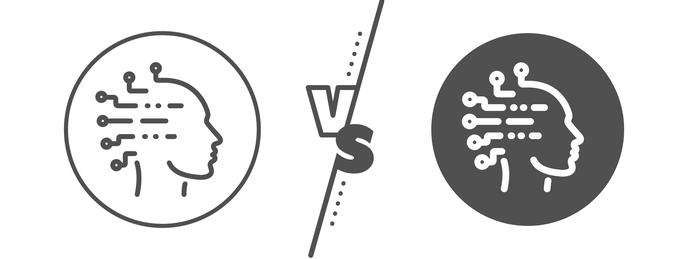In the twenty-first century, you’ve almost certainly heard the words “artificial intelligence” and “machine learning.” This is the technology era, and it is estimated that in 2021, 80% of emerging technologies will be AI-based. And, internationally, 37% of businesses are using AI in some way to boost their day-to-day operations.
Amazon, for example, reduced its delivery time by over 225% thanks to machine learning. So, if you’re not sure what these words mean and how to identify the difference between them, we will discuss their significant differences below.
Overview of Artificial Intelligence
Artificial intelligence, or AI, is the creation of a human-made machine mimicking human intelligence. The system has a computerized brain that can learn and solve problems in the same way that the human brain does. AI is achieved by first researching how the human brain thinks and how humans learn, determine, and work when trying to solve a problem and then using the outcomes to develop intelligent software and systems. When all of the ingredients are present, you can think of algorithms as a recipe that the computer must follow.
Artificial intelligence can be divided into three types:
- Narrow AI
- General AI
- Super AI
Overview of Machine Learning
Machine learning is a computer science subfield which is also known as predictive analytics or predictive modeling. Its goal is to create new and leverage existing algorithms to learn from data to develop generalizable services that make accurate predictions or find trends, particularly with existing and new unseen data.
Machine learning, as previously mentioned, uses algorithms to automatically model and find patterns in data to predict a specific output or response. Statistics and mathematical optimization are extensively used in these algorithms.
The process of optimization entails determining the smallest or largest value (minima or maxima). The process is also known as a loss or cost function in the minimization case. Gradient descent is one of the most common optimization algorithms in machine learning, and the normal equation is another.
In a nutshell, machine learning uses learning algorithms and optimization techniques to learn a highly accurate predictive or classifier model automatically or discover unknown patterns in data.
Machine learning is also divided into four different categories:
- Supervised
- Unsupervised
- Semi-supervised
- Reinforcement
What is the Difference between Artificial Intelligence and Machine Learning?
| Artificial Intelligence | Machine learning |
|---|---|
| Artificial intelligence (AI) is a technology that allows a computer to mimic human actions. | Machine learning is a subset of AI that allows a machine to learn from past data without programming explicitly. |
| Goal: The goal of AI is to make an intelligent computer system like humans to solve complex problems. | Goal: Machine learning aims to allow machines to learn from data and produce accurate results. |
| Scope: AI has an extensive scope. | Scope: Machine learning is constrained in scope. |
| Task: AI builds an autonomous system able to perform a variety of complex tasks. | Task: Machine learning aims to create machines that can only perform the tasks for which they have been trained. |
| Results: AI systems are concerned about maximizing the chances of success. | Results: Machine learning is mainly concerned with accuracy and patterns. |
| Wisdom: AI leads to intelligence or wisdom. | Knowledge: ML leads to knowledge. |
| Outcome: Artificial intelligence can evaluate a variety of options before selecting the right one. | Outcome: Machine learning will choose the only answer it sees as the best, regardless of whether it is the best. |
Final Thoughts
Artificial intelligence and machine learning are both science and mythical inventions. The idea that machines could think and perform tasks in the same way that humans do dates back thousands of years. Cognitive truths expressed in AI and ML systems are also not new. Artificial intelligence is the best and most logical next step in the evolution of computers and technology. Machine learning makes significant progress toward that goal when creating true AI. Moving in the right direction, having a clear vision, and having a distinct and unique purpose can help all of humanity.
To learn more about the variations in AI and ML and how both can be used as tools to advance B2B marketing initiatives, connect with the team at Byonic.AI.

